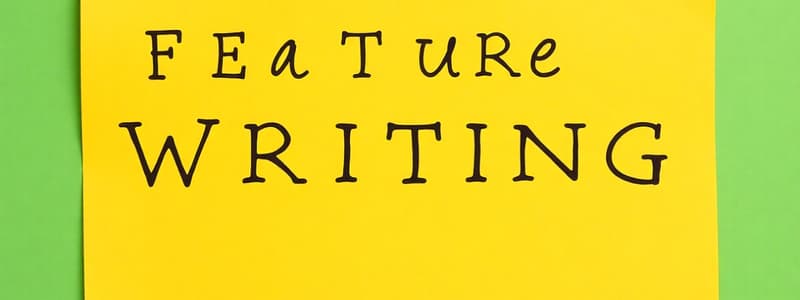Podcast
Questions and Answers
Which of the following best describes the primary difference between hard news and feature articles?
Which of the following best describes the primary difference between hard news and feature articles?
- Hard news uses multiple quotes whereas feature articles use few to none.
- Hard news focuses on entertainment, while feature articles prioritize immediate information.
- Hard news prioritizes immediate information and allows readers to stop at any point, whereas feature articles aim to keep the reader engaged until the end. (correct)
- Feature articles are written in journalistic form, hard news is not.
A writer is deciding whether to pitch a story idea as a hard news piece or a feature. Which factor should weigh most heavily toward choosing the feature format?
A writer is deciding whether to pitch a story idea as a hard news piece or a feature. Which factor should weigh most heavily toward choosing the feature format?
- The story's enduring relevance or unique perspective could engage readers over time. (correct)
- The story involves complex data that requires detailed analysis.
- The story's main value lies in its immediate impact and relevance to current events.
- The story can be covered within a very short timeframe.
What is the primary goal of incorporating elements of fiction, such as character development and dialogue, into feature writing?
What is the primary goal of incorporating elements of fiction, such as character development and dialogue, into feature writing?
- To engage readers emotionally and immerse them in the story. (correct)
- To blur the lines between journalism and creative writing.
- To shorten the article length.
- To allow the writer to fabricate details and enhance the story.
According to Steve Rushin, what is the most challenging part of writing columns or longer features?
According to Steve Rushin, what is the most challenging part of writing columns or longer features?
When considering a story idea, what key question should a feature writer ask to ensure the piece will resonate with readers?
When considering a story idea, what key question should a feature writer ask to ensure the piece will resonate with readers?
Which of the following best represents the shift in focus when moving from 'newsworthiness' to 'feature worthiness'?
Which of the following best represents the shift in focus when moving from 'newsworthiness' to 'feature worthiness'?
What does Abby Vesoulis of Time magazine consider when deciding whether to invest time in reporting a feature story?
What does Abby Vesoulis of Time magazine consider when deciding whether to invest time in reporting a feature story?
In the context of feature writing, what is the significance of using people to 'bring us into and move us through the stories'?
In the context of feature writing, what is the significance of using people to 'bring us into and move us through the stories'?
Which of the following feature story structures is most likely to focus on the personal experiences and insights of an individual?
Which of the following feature story structures is most likely to focus on the personal experiences and insights of an individual?
According to the content, what should a writer consider during the 'organizing' stage of creating a feature article?
According to the content, what should a writer consider during the 'organizing' stage of creating a feature article?
Why is versatility particularly valuable for journalism students?
Why is versatility particularly valuable for journalism students?
Which of the following is NOT a key element used in feature writing according to the text?
Which of the following is NOT a key element used in feature writing according to the text?
How does feature writing differ from news writing in its approach to 'stiffness'?
How does feature writing differ from news writing in its approach to 'stiffness'?
What is the significance of finding 'the big worlds in these small ideas' according to Steve Rushin?
What is the significance of finding 'the big worlds in these small ideas' according to Steve Rushin?
What should a writer consider during the 'information gathering' stage of creating a feature article?
What should a writer consider during the 'information gathering' stage of creating a feature article?
What should a writer consider during the 'writing' stage of creating a feature article?
What should a writer consider during the 'writing' stage of creating a feature article?
How is the 'inverted pyramid' structure typically used in hard news articles?
How is the 'inverted pyramid' structure typically used in hard news articles?
What is the purpose of the 'nut graph' in a feature article?
What is the purpose of the 'nut graph' in a feature article?
Which of the following best describes the reader's perspective when engaging with a magazine or article?
Which of the following best describes the reader's perspective when engaging with a magazine or article?
What is the ultimate form for a piece, feature, article, or story?
What is the ultimate form for a piece, feature, article, or story?
Flashcards
Feature Writing
Feature Writing
A style of nonfiction that presents facts and information using narrative techniques like character development, descriptions, and dialogue.
Human Spin in Feature Writing
Human Spin in Feature Writing
Presenting facts and information with a more narrative style, using people to bring us into and move us through the stories.
Feature Worthiness
Feature Worthiness
Focuses on in-depth exploration of a topic, person, or event, prioritizing reader engagement over strict timeliness.
Types of Feature Articles
Types of Feature Articles
Signup and view all the flashcards
Reader Benefit
Reader Benefit
Signup and view all the flashcards
Know your reader
Know your reader
Signup and view all the flashcards
Unique Angle
Unique Angle
Signup and view all the flashcards
Study Notes
- Journalism students face a transition from writing thesis-driven essays with parenthetical citations to journalism's summary ledes with speaker attribution.
- They must adapt from the inverted pyramid style (most important info first) to narrative storytelling with a nut graph and a crafted conclusion.
- Versatility is key; different articles suit different purposes.
- Hard news delivers immediate information, whereas features ("soft news") aim to engage readers until the end.
Features Defined
- Features use research, interviews, facts, and quotes to craft nonfiction narratives in journalistic form.
- Feature writing relates facts and information in a narrative style, employing fiction techniques like characters, descriptions, anecdotes, scene-setting, and dialogue.
- Readers should be taught, entertained, captivated, and involved when reading features.
- Feature writing presents facts with a human spin, using people to drive stories.
- "Feature worthiness" broadens the scope beyond timeliness, focusing on novel or interesting topics.
- Features emphasize the people involved in a story.
- “How can I figure out how to tell that story that hasn’t been told already", key to success
- Feature is an umbrella term for various story structures.
- Features blend nonfiction (truth) with fiction (style) elements like plot, symbolism, character development, and dialogue.
Reader Focus
- Readers always consider "What's in this for me?".
- Key questions to consider:
- Who is your reader?
- What does he or she want to know?
- Overlooked or seemingly silly ideas can work if told well.
- Find the universal and epic in small ideas.
- Readers need to benefit from what they read so they need to be considered through every stage of article creation
Article Creation Stages
- Idea: How will this story serve the reader?
- Information gathering: What does the reader need to know, and who can provide that information?
- Organizing: How should the story be structured to entertain, inform, and compel readers?
- Writing: Which material is essential and engaging for the reader?
- Keeping the reader in mind throughout the writing process increases chances of success.
Studying That Suits You
Use AI to generate personalized quizzes and flashcards to suit your learning preferences.



